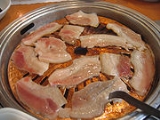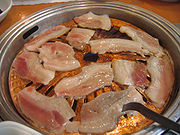
Samgyeopsal
Encyclopedia
Samgyeopsal is a popular Korean dish. Commonly served as an evening meal, it consists of thick, fatty slices of pork belly
meat (similar to uncured bacon
). The meat, usually neither marinated nor seasoned, is cooked on a grill at the diners' table. Usually diners grill the meat themselves and eat directly from a grill.
 Samgyeopsal is one of the most expensive parts of pork even though the price of pork in South Korea changes continuously. The high popularity of Samgyeopsal makes it expensive in South Korea. Thus, South Korea imports wholesale Samgyeopsal from Belgium, Netherlands and other countries for the purpose of price stabilization because imported Samgyeopsal is much cheaper than domestic. Also, the South Korean government is planning to import 70000t of Samgyeopsal with no tariff in the second half year of 2011. Thus, importation of Samgyeopsal is expected to expand.
Samgyeopsal is one of the most expensive parts of pork even though the price of pork in South Korea changes continuously. The high popularity of Samgyeopsal makes it expensive in South Korea. Thus, South Korea imports wholesale Samgyeopsal from Belgium, Netherlands and other countries for the purpose of price stabilization because imported Samgyeopsal is much cheaper than domestic. Also, the South Korean government is planning to import 70000t of Samgyeopsal with no tariff in the second half year of 2011. Thus, importation of Samgyeopsal is expected to expand.
Samgyeopsal is popularly consumed both at restaurants and at home, and also used as an ingredient for other Korean dishes, such as kimchi jjigae.
According to a 2006 survey by Agricultural Cooperatives in Korea (농업협동조합), 85% of South Korean adults surveyed stated their favorite pork is samgyeopsal. The survey also showed 70% of recipients eat the meat at least once a week.
(sangchu; 상추) and sliced raw garlic
, but very often the meat is served with other accompaniments, such as perilla leaves
(kkaennip; 깻잎), sliced green chili pepper
s, shredded green onions
, sliced raw onion
s, and aged kimchi
(mugeunji; 묵은지). Garlic, onions, and kimchi can be either grilled with the meat or consumed raw with the cooked meat.
(쌈장), a paste consisting of chili paste (gochujang
; 고추장), soybean paste (doenjang
; 된장), sesame oil
(참기름), and other ingredients; the other is gireumjang (기름장), made with salt
and sesame oil, sometimes also with a small amount of black pepper
. Usually ssamjang is used when a diner eats samgyeopsal with vegetable accompaniments, and gireumjang when a diner wants to taste the cooked meat itself.
Pork belly
Pork belly is a boneless cut of fatty meat derived from the belly of a pig. Pork belly is popular in Asian cuisine, and forms a part of many traditional European dishes such as the Alsatian Choucroute garnie, the Swiss Berner Platte, and the German Schlachtplatte...
meat (similar to uncured bacon
Bacon
Bacon is a cured meat prepared from a pig. It is first cured using large quantities of salt, either in a brine or in a dry packing; the result is fresh bacon . Fresh bacon may then be further dried for weeks or months in cold air, boiled, or smoked. Fresh and dried bacon must be cooked before eating...
). The meat, usually neither marinated nor seasoned, is cooked on a grill at the diners' table. Usually diners grill the meat themselves and eat directly from a grill.
Name
The literal meaning of the word is "three (sam; 삼) layered (gyeop; 겹) flesh (sal;살)," referring to the ostensible three layers that are visible in the meat. One can also find ogyeopsal (오겹살), with o meaning "five".Popularity in Korea

Samgyeopsal is popularly consumed both at restaurants and at home, and also used as an ingredient for other Korean dishes, such as kimchi jjigae.
According to a 2006 survey by Agricultural Cooperatives in Korea (농업협동조합), 85% of South Korean adults surveyed stated their favorite pork is samgyeopsal. The survey also showed 70% of recipients eat the meat at least once a week.
Accompaniments
The most common accompaniments for samgyeopsal are lettuceLettuce
Lettuce is a temperate annual or biennial plant of the daisy family Asteraceae. It is most often grown as a leaf vegetable. It is eaten either raw, notably in salads, sandwiches, hamburgers, tacos, and many other dishes, or cooked, as in Chinese cuisine in which the stem becomes just as important...
(sangchu; 상추) and sliced raw garlic
Garlic
Allium sativum, commonly known as garlic, is a species in the onion genus, Allium. Its close relatives include the onion, shallot, leek, chive, and rakkyo. Dating back over 6,000 years, garlic is native to central Asia, and has long been a staple in the Mediterranean region, as well as a frequent...
, but very often the meat is served with other accompaniments, such as perilla leaves
Perilla
Perilla is the common name of the herbs of the genus Perilla of the mint family, Lamiaceae. In mild climates, the plant reseeds itself. There are both green-leafed and purple-leafed varieties, which are generally recognized as separate species by botanists. The leaves resemble stinging nettle...
(kkaennip; 깻잎), sliced green chili pepper
Chili pepper
Chili pepper is the fruit of plants from the genus Capsicum, members of the nightshade family, Solanaceae. The term in British English and in Australia, New Zealand, India, Malaysia and other Asian countries is just chilli without pepper.Chili peppers originated in the Americas...
s, shredded green onions
Scallion
Scallions , are the edible plants of various Allium species, all of which are "onion-like", having hollow green leaves and lacking a fully developed root bulb.-Etymology:The words...
, sliced raw onion
Onion
The onion , also known as the bulb onion, common onion and garden onion, is the most widely cultivated species of the genus Allium. The genus Allium also contains a number of other species variously referred to as onions and cultivated for food, such as the Japanese bunching onion The onion...
s, and aged kimchi
Kimchi
Kimchi , also spelled gimchi, kimchee, or kim chee, is a traditional fermented Korean dish made of vegetables with varied seasonings. There are hundreds of varieties of kimchi made with a main vegetable ingredient such as napa cabbage, radish, green onions or cucumber. It is the most common...
(mugeunji; 묵은지). Garlic, onions, and kimchi can be either grilled with the meat or consumed raw with the cooked meat.
Dipping sauce
Samgyeopsal is almost always served with at least two kinds of dipping sauces. One is ssamjangSsamjang
Ssamjang is a thick, spicy paste used with food wrapped in a leaf in Korean cuisine. The sauce is made of doenjang, gochujang, sesame oil, onion, garlic, green onions, and optionally brown sugar.-Use:...
(쌈장), a paste consisting of chili paste (gochujang
Gochujang
Gochujang is a savory and pungent fermented Korean condiment. Traditionally, it has been naturally fermented over years in large earthen pots outdoors, more often on an elevated stone platform, called jangdokdae in the backyard...
; 고추장), soybean paste (doenjang
Doenjang
Doenjang is a traditional Korean fermented soybean paste. Its name literally means "thick paste" in Korean.-Production:...
; 된장), sesame oil
Sesame oil
Sesame oil is an edible vegetable oil derived from sesame seeds. Besides being used as a cooking oil in South India, it is often used as a flavor enhancer in Chinese, Japanese, Korean, and to a lesser extent Southeast Asian cuisine.The oil from the nutrient rich seed is popular in alternative...
(참기름), and other ingredients; the other is gireumjang (기름장), made with salt
Salt
In chemistry, salts are ionic compounds that result from the neutralization reaction of an acid and a base. They are composed of cations and anions so that the product is electrically neutral...
and sesame oil, sometimes also with a small amount of black pepper
Black pepper
Black pepper is a flowering vine in the family Piperaceae, cultivated for its fruit, which is usually dried and used as a spice and seasoning. The fruit, known as a peppercorn when dried, is approximately in diameter, dark red when fully mature, and, like all drupes, contains a single seed...
. Usually ssamjang is used when a diner eats samgyeopsal with vegetable accompaniments, and gireumjang when a diner wants to taste the cooked meat itself.
Consumption
Prior to consumption, the large slice of the pork belly is cut into smaller pieces with scissors. A common way to consume samgyeopsal is to place a slice of the cooked meat on a leaf of lettuce or a perilla leaf or both, with some cooked rice and ssamjang, and to roll it up in the leaf and eat it. It is usually called sangchu-ssam (상추쌈). Cooked rice and other foods wrapped in Korean lettuce can also be called sangchu-ssam. Any combination of the vegetable accompaniments mentioned above can be added to the roll according to preference, the most popular is sliced garlic. Many people also add in kimchi, mushrooms, bean sprouts, and grilled onions. Usually, different types of banchan are added. Part of the reason so many people enjoy this food is they can customize it to their liking.See also
-
- PorkPorkPork is the culinary name for meat from the domestic pig , which is eaten in many countries. It is one of the most commonly consumed meats worldwide, with evidence of pig husbandry dating back to 5000 BC....
- Pork bellyPork bellyPork belly is a boneless cut of fatty meat derived from the belly of a pig. Pork belly is popular in Asian cuisine, and forms a part of many traditional European dishes such as the Alsatian Choucroute garnie, the Swiss Berner Platte, and the German Schlachtplatte...
- BaconBaconBacon is a cured meat prepared from a pig. It is first cured using large quantities of salt, either in a brine or in a dry packing; the result is fresh bacon . Fresh bacon may then be further dried for weeks or months in cold air, boiled, or smoked. Fresh and dried bacon must be cooked before eating...
- Korean barbecueKorean barbecueKorean barbecue, or gogi gui literally "meat + roasted meat", refers to the Korean method of grilling beef, pork, chicken, or other types of meat. Such dishes are often prepared at the diner's table on gas or charcoal grills that are built into the center of the table itself...
- Korean cuisine
- List of Korea-related topics
- Pork

